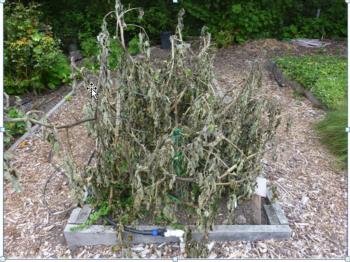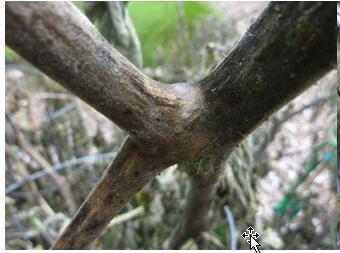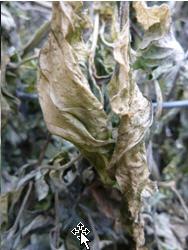Tomato Late Blight Report
TOMATO LATE BLIGHT REPORT
Reported by Electra Field & Carol Fahy, Master Gardeners, April, 2012.
Led by Master Gardeners Electra Field and Carol Fahy.
The Master Gardeners at Elkus Ranch designed a study in 2011 to compare the yield and vigor of traditionally propagated tomatoes vs. grafted tomatoes. Our goal was to see if the extra cost of the grafted tomatoes was justified by additional production. Varieties used were Sun Gold and Sweet Million. Unfortunately, the study was inconclusive due to an infection of Late Blight that destroyed all the plants.
Late Blight, pathogen Phytophthora infestans, is a very serious and highly communicable fungus-type disease. This is the same pathogen that caused the infamous Irish Potato Famine in the 1800s. ‘Phytophthora’ in Latin means “plant destroyer” and this picture is a fine example of it. 
Signs of Late Blight are large, greenish-brown spots on leaves; brown, often large fuzzy lesions on stems; patches of white, powdery spores on the undersides of leaves and oily-looking brown spots on fruits.


Fungicides do not cure this disease but may control it. The problem with fungicide use is that spores will continue to be produced, increasing the risk of infection of nearby plants. For this reason fungicide was not used in this study and the tomato plants at Elkus were pulled out and destroyed in August. Extra caution needs to be practiced when removing plants since spores of this fungus can become airborne and infect neighboring plants and soil. To remove infected plants it is best to pull them out in the middle of a sunny day when leaves are their driest and any dislodged spores will likely be exposed to UV radiation. Put infected plant tissue in a plastic bag and leave the bag in the sun. The heat from the sun will kill the fungus and the plant. Some studies recommend burying or covering the plastic bag with a tarp for several days. Do not compost the plants since the fungus will only survive to infect other nightshade plants. In our study, we believe the soil where the tomatoes were grown is contaminated and recommend that no tomato studies be conducted at Elkus Ranch for two years to ensure the fungus does not overwinter and survive to infect future plants. Since the spores of Late Blight can be transported through the air, we strongly recommend that home gardeners, who have discovered Late Blight in their gardens, notify their neighbors in an effort to contain this fungus. Containment is the best means of managing it.
While containment is a very good management method, prevention is the best. Check plants before planting them to ensure they are disease free. Avoid overhead watering and sprinklers. In climate zone 17 the best location to grow tomatoes is in a greenhouse or under overhead protection such as the eaves of the house or on a covered porch. If cases of Late Blight have been discovered in your area, discontinue growing nightshades for two years.
There are tomato varieties that are tolerant of Late Blight. Be careful, this does not mean the varieties are resistant to the disease. Information on tomato varieties and Late Blight can be found at:
Cornell University, Vegetalbe MD online, scroll down to 'Tomato' for a series of articles.
___________________________________________________________________
For more information on Late Blight and references used in this article go to:
UCDavis, Integrated Pest Management website, click here.
Cornell University, Late Blight on Tomatoes, click here.
For more information, please contact the Master Gardener Help Line at (650) 726-9059 ext 107
Written by: Electra Field and Carol Fahy, San Mateo/San Francisco Master Gardeners.
